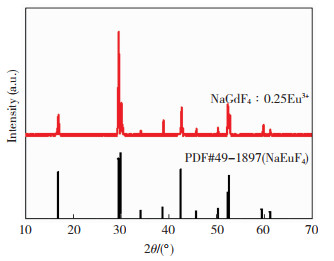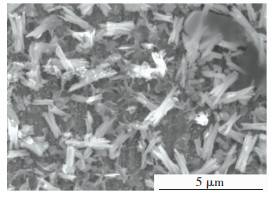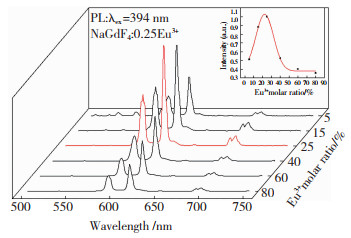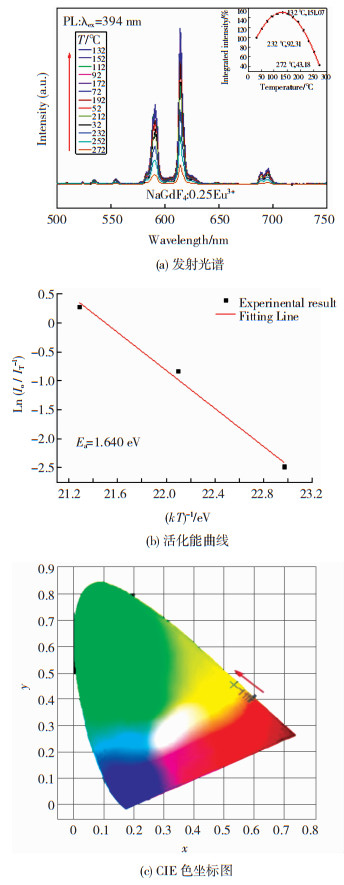2. 广西经正科技开发有限责任公司,南宁 530007;
3. 广西大学 化学化工学院,南宁 530004
2. Guangxi Jingzheng Science and Technology Development Co.Ltd., Nanning 530007, China;
3. Collegeof Chemistry and Chemical Engineering, Guangxi University, Nanning 530004, China
白光发光二极管(LED)背光源的液晶显示器具有色彩还原性好、功耗低、寿命长等优势[1]。但考虑到技术、性能和成本等综合因素,液晶显示LED背光仍沿用照明LED的光转换方式“蓝光LED芯片+荧光粉”产生白光,然后经过滤光、分光后产生所需的红、蓝和绿三色光,因此,荧光粉是决定LED背光液晶显示器色域的关键因素。
目前白光LED的实现方案主要归纳为以下3种:1)激发按一定比例组合红、绿、蓝三色高亮度的LED芯片,从而获得白光;2)将蓝色LED芯片作为激发源激发的黄色荧光粉,芯片发出的部分蓝光与黄色荧光粉发出的黄光复合继而产生白光;3)紫外(UV)-近紫外光(NUV)LED芯片激发的红、绿、蓝三色荧光粉,最后红、绿、蓝三色光复合形成白光。但这3种方法都存在各自的缺陷,尚需研究一种能够有效解决这些问题的方法[2-4]。
与传统光源相比,使用红光荧光粉制备的暖白光LED具有高显色指数和低色温的特点,展示出很大的竞争力。目前,研究者在合成红光荧光粉方面,已获得了较多成果,例如目前已合成的红光荧光粉有稀土激活的硫化物、钼酸盐、钨酸盐、氮化物等[5-11]。但这些红光荧光粉本身存在的缺点阻碍了其在LED照明领域中的应用。例如,硫化物荧光粉在LED工作的温度下(150~180 ℃)易受热分解[12-13]。此外,以氮化物作为基质的红光荧光粉,由于具有较宽的发射带而限制了其发光效率的提高[14-15]。相比之下,氟化物具备较好的化学稳定性和相对较低的声子能等优势[16-17]。然而随着温度的升高,几乎所有现有的固体发光材料都会受到严重的热淬灭影响[18-21],即荧光粉在高温情况下,其发射强度会产生极大的衰减,从而影响发光的质量。而发生热猝灭的主要原因是由于激发态电子非辐射跃迁概率随温度升高而提高,能量随之转变成热能而产生大量损失。目前,寻找高效、高发光热稳定性的荧光粉已成为LED研究领域的一个挑战。而目前已报道的具有最高发光热稳定性稀土荧光的材料,是在200 ℃才发生猝灭的Na3-2xSc2(PO4)3∶xEu2+的零热猝灭蓝色荧光粉[22]。关于NaLnF4(Ln=Gd,Yb等) 中单掺Eu3+的报道很多[23],但鲜见有在NaLnF4(Ln=Gd,Yb等)基质中单掺杂Eu等稀土离子而得到具有良好发光热稳定性的荧光粉的报道。本文在NaGdF4基质中掺杂Eu3+的实验中,得到了一种具有高发光热稳定性的红光荧光粉,并进一步对其物相,光致发光和电致发光等性能展开了研究。
1 实验 1.1 试剂与仪器实验所用Gd(NO3)3·6H2O,Eu(NO3)3·6H2O,NaNO3,NH4F,聚乙二醇等试剂均为分析纯(AR)。
本文利用日本理学公司Rigaku D/max 2500V X射线衍射仪(XRD)进行产物物相分析;用日本日立公司S-3400N型扫描电子显微镜(SEM)进行产物形貌分析;采用美国HORIBA公司的Fluoro Max4型荧光光谱仪测试产物的激发光谱及发射光谱(photoluminescence excitation and photoluminescence (PLE & PL));用Edinburgh FLS980荧光光谱仪做荧光寿命测试。LEDs的性能使用湖州升谱SPL720 LED快速光谱分析系统进行测量。
1.2 样品制备以NaGdF4∶0.1Eu3+为例,其合成步骤如下。
1) 首先将试剂按照F∶Na∶Gd∶Eu = 5.0∶1.0∶0.9∶0.1的摩尔比量取相应的溶液,稀土离子总量为0.01 mol,取5 mL的聚乙二醇(2%),9 mL Gd(NO3)3(1 mol/L),1 mL Eu(NO3)3(1 mol/L),4 mL NaNO3(2.5 mol/L)溶液混合,用磁力搅拌器搅拌15 min使之充分混合。
2) 而后取1.85 gNH4F (0.05 mol),用20 mL的去离子水溶解,待全部溶解后,一边搅拌一边将步骤1)中混合溶液滴加到NH4F溶液中,这时会产生大量白色沉淀,滴加完成后继续搅拌60 min,将搅拌好的混合溶液转移到水热釜中,密封后放入烘箱中,在120 ℃下保温12 h。
3) 再次,待水热釜冷却到室温后,收集沉淀,抽滤,用去离子水和酒精洗涤3~4次,在120 ℃下烘干3 h,研磨后即可得到实验样品。其他含量的NaGdF4∶xEu3+(x=0.05, 0.15, 0.25, 0.4, 0.6, 0.8)也依此步骤进行合成。
2 结果与讨论 2.1 物相和形貌分析图 1是NaGdF4∶0.25Eu3+样品的XRD谱图,可以看出,样品的特征峰突出,说明样品的结晶度比较好,与标准卡片PDF#49-1897中的NaEuF4(六方晶系,P6/*(175)空间群)的匹配度很高。根据Jade 6.5软件(布拉格方程)指标化得到NaGdF4∶0.25Eu3+的样品的晶格常数为a=b=0.605 585 nm,c=0.359 565 nm,与NaEuF4的晶格常数a=b=0.6059 nm,c= 0.3625 nm非常接近,这证明Eu3+成功地掺杂进入NaGdF4。图 2是NaGdF4∶0.25Eu3+样品的SEM图,可以看到,样品在微观形态上呈现分叉状,是长度约2.5 μm的棒状晶体,出现这种形状,是由于其是多个晶体形成的。

|
图 1 NaGdF4∶0.25Eu3+的XRD谱图 Fig.1 XRD patterns of NaGdF4∶0.25Eu3+sample |

|
图 2 样品NaGdF4∶0.25Eu3+的SEM形貌 Fig.2 SEM image of NaGdF4∶0.25Eu3+ sample |
图 3是NaGdF4∶0.25Eu3+样品在常温下的荧光性能及Eu3+的能级图。由图 3(a)可得,样品的激发光谱在320~500 nm,其中394、415、644 nm处的激发峰分别对应Eu3+从基态7F0跃迁到5L6、5D3及5D3的吸收(图 3(c))。图 3(a)中样品的发射光谱,依据Judd-Ofelt理论可知,Eu3+离子在587 nm处的发射光为橙色光,属于5D0→7F1磁偶极跃迁(图 3(c))。Eu3+在611 nm处的发射光为红色光,属于5D0→7F2的电偶极跃迁。此时,Eu3+离子位于非中心对称性的晶格格位,且发射光将以电偶极跃迁(5D0→7F2)(图 3(c))为主导。该发射对晶格环境极为敏感,其强度与基质晶体场大小的变化高度相关。由图 3(a)可得在发射光谱中,611 nm处的发射峰为最强峰,这说明发射光谱属于以电偶极发射为主导的光谱,也说明发光Eu3+离子处于非对称中心的格位,这与图 1的无对称中心的P6空间群的对称性相吻合。

|
图 3 样品NaGdF4∶0.25Eu3+的荧光性能及Eu3+的能级图 Fig.3 Luminescent properties of NaGdF4∶0.25Eu3+ sample and Eu3+ energy level diagram: (a) PLE and PL spectra; (b)luminescent lifetime curve; (c) Eu3+ energy level diagram |
利用Edinburgh FLS980荧光光谱仪做荧光寿命衰减曲线的测试,以氙灯光源作为脉冲光源,激发光波长为394 nm,监测光波长为611 nm。图 3(b)是NaGdF4∶0.25Eu3+的荧光寿命曲线,该寿命的实验曲线与以下单指数方程(1)拟合性能非常好[24]。
| $ I=A \exp \left(-t / \tau_{\mathrm{R}}\right)+B $ | (1) |
式中:I为相对强度;t为衰减时间;τR是荧光寿命;A、B为常数。通过拟合得出NaGdF4∶0.25u3+样品的荧光寿命为6.64 ms。
图 4所示为NaGdF4∶xEu的发射光谱图。由图 4可得,随着Eu3+量的增加,Eu3+的特征发射峰611 nm的强度不断增强,直至0.25才下降。发射光的浓度淬灭机理取决于临界距离Rc, 该距离可用公式(2)描述[25]。
| $ R_{\mathrm{c}}=2 \times\left(\frac{3 V}{4 {\rm{ \mathsf{ π} }} X_{\mathrm{c}} N}\right)^{1 / 3} $ | (2) |

|
图 4 NaGdF4∶xEu3+的发射光谱 Fig.4 PL spectra of NaGdF4∶xEu3+ |
式中:V为晶胞体积;N为单位晶胞化学式单位的数目;Xc为临界浓度,能量传递的机理主要有两种:交换相互作用机理和多极子相互作用机理。交换相互作用机理要求Rc小于0.5 nm,反之,如果Rc大于0.5 nm,就属于多极子相互作用机理。NaGdF4∶xEu3+属于六方晶型,在NaGdF4∶xEu3+晶体中N=1.5, 由Jade可得V=0.115 nm3,由图 4的发射光谱图可知, 发生淬灭时的物质的量的百分比为0.25,所以Xc=0.25。将前面数据代入式(2)得Rc=0.836 nm>0.5 nm,故Eu3+之间的能量传递是多极-多极相互作用。
2.3 NaGdF4∶Eu3+的荧光热稳定性分析图 5是样品NaGdF4∶0.25Eu3+在不同温度下的荧光热性能。图 5(a)是在不同温度下的发射光谱图,可以看到,随着温度的升高,样品发射光谱的积分强度曲线类似一条有最大值的抛物线,该积分强度先升后降,当温度升高到132 ℃后积分强度达到最高值,该强度为室温时初始值的151.07%,而后随着温度的继续升高强度开始下降,当温度升高至226 ℃时,强度为常温时初始值的100%,所以该样品在226 ℃以下,样品的发光性能较好。上述现象就是负的热猝灭效应。另外,经过5个循环的实验,图 5(a)及其中插图的曲线基本保持不变,呈现出良好的重现性。在激发光强度保持不变的情况下,发光的积分强度却随着温度的增加而增强,针对此种现象,有文献指出其机理是发光材料内部缺陷积蓄的能量被转换成为光辐射的能量的缘故[26-27]。基于图 5(a)的结果,本文推测负热猝灭效应的机理如下。除了基质内部缺陷积蓄的能量被转换成光辐射能量外,从宏观上不难推测,内部缺陷积蓄的能量能够源源不断地被转换成光辐射能,是因为变温测试外部加热器件所提供的热量首先被转换成内部缺陷的积蓄能,然后该积蓄能又被进一步转换成光辐射能。换言之,在进行变温测试时,有部分热辐射的能量被转换成为光辐射的能量。

|
图 5 样品NaGdF4∶0.25Eu3+在不同温度下的荧光热性能 Fig.5 Luminescent thermal performance of NaGdF4:0.25Eu3+ sample at different temperatures: (a) PL spectra; (b) activation energy curve; (c)CIE color coordinates |
根据温度淬灭经典理论,荧光猝灭的活化能可由下公式(3)求算得到[28]。
| $ I_{T}=\frac{I_{0}}{1+R^{*} \exp \left(-E_{\mathrm{a}} / k T\right)} $ | (3) |
式中:IT是温度为T时的发光强度;I0为常温下的发光强度;R和k为常数;T为绝对温度;Ea是热猝灭过程的活化能。式(4)由式(3)变形得到。
| $ \operatorname{Ln}\left(I_{0} / I_{T}-1\right)=\operatorname{Ln} A-E_{\mathrm{a}} /(k T) $ | (4) |
图 5(b)是Ln(I0/IT-1)与1/(kT)之间的函数拟合直线,该拟合直线的斜率为-1.640,所以NaGdF4∶0.25Eu3+样品热猝灭活化能为1.640 eV,活化能非常高,说明样品具有很高的热稳定性。图 5(c)是不同温度下NaGdF4∶0.25Eu3+样品的CIE图,35~295 ℃温度下的色坐标分别为(以20 ℃为间隔)(0.592 6,0.402 4),(0.594 2,0.401 1),(0.595 4,0.4),(0.595 1,0.400 2),(0.595 4,0.4),(0.594 6,0.400 6),(0.593 2,0.401 9),(0.591 3,0.403 5),(0.588 9,0.405 7),(0.583 3,0.410 4),(0.574 4,0.418),(0.561 5,0.428 9),(0.532 4,0.453 8),可以看到,在温度高于232 ℃后,样品的色坐标明显向黄光区域移动,而低于这个温度,色坐标变化不大,说明NaGdF4∶0.25Eu3+优异的热稳定性能。
2.4 原型红光LEDs的发光性能原型红光LEDs的发光性能如图 6所示。该LEDs由样品NaGdF4∶0.25Eu3+和环氧树脂混合后涂覆在395 nm UV芯片上组装而得,并在不同驱动电流下进行测试。图 6(a)为该LEDs的电致发光光谱,该光谱由UV的发光和NaGdF4∶0.25Eu3+的发光组成。图 6(b)是该LEDs在不同驱动电流下的红色比,可以看到:驱动电流越大,红色越大;且红色与驱动电流的大小成正比的线性关系。通常,芯片的驱动电流越大,则芯片的工作温度就越高。由图 5(a)的插图可得,在132 ℃之前,荧光积分强度随着温度的升高而增强。显然,图 6(b)的结果与图 5(a)插图的结果互相验证,且可进一步推测出在50 mA电流的驱动下UV芯片的工作温度没有超过132 ℃。总之,图 6(b)的结果说明样品NaGdF4∶0.25Eu3+具有良好的热稳定性。图 6(c)为该LEDs在20 mA驱动电流下的发光照片,呈现出紫红色。图 6(d)为利用图 6(a)的光谱数据得到该LEDs的色度坐标:x=0.417 7,y=0.234 1,同样说明该LEDs发出的是紫红光。

|
图 6 原型LEDs (NaGdF4∶0.25Eu3++395 nm UV芯片)的发光性能 Fig.6 Luminescent performances of prototype LEDs (NaGdF4∶0.25Eu3++395 nm UV chips): (a)electroluminescence spectrum under 20 mA drive current; (b)red ratio under different drive currents; (c) luminescence photo of LEDs under 20 mA drive current; (d) CIE chromaticity diagram obtained from spectrum in fig. 6(a) |
本文采用水热合成法制备了一系列NaGdF4∶xEu3+红光荧光粉,获得了最佳样品NaGdF4∶0.25 Eu3+。
1) XRD结果表明,样品为六方相晶体,与标准卡片NaEuF4的结构有很好的匹配,SEM结果表明形貌为微米级棒状晶体。
2) 本实验变温测试结果展现出负的热猝灭效应,且样品具有优异的高温稳定性,使其在WLED工作温度范围内(150 ℃左右)能保持良好的发光性能。
3) 用NaGdF4∶Eu3+和395 nm UV芯片组装得到原型LEDs,在不同驱动电流下的红色比也证实该样品具有良好的热稳定性。
| [1] |
华强电子网. LED背光成2009年液晶电视的重要发展趋势[EB/OL]. (2016-08-10). http://www.hqew.com/tech/news/173817.html.
|
| [2] |
李波, 王育华, 沈雷军, 等. 白光LED用(YxGd1-x)(P, W)O4∶ Eu红光荧光粉的发光性能研究[J]. 中国稀土学报, 2015, 33(5): 535-541. LI Bo, WANG Yuhua, SHEN Leijun, et al. Study on luminescence properties of (YxGd1-x)(P, W)O4∶Eu red phosphor for white LED[J]. Journal of the Chinese Society of Rare Earths, 2015, 33(5): 535-541. DOI:10.11785/S1000-4343.20150501 |
| [3] |
李盼来, 王振动, 罗志远, 等. 紫外-近紫外基白光LEDs用荧光粉的研究进展[J]. 人工晶体学报, 2015, 44(11): 2954-2963. LI Panlai, WANG Zhendong, LUO Zhiyuan, et al. Progress in UV-near UV phosphors for LEDs[J]. Journal of Synthetic Crystals, 2015, 44(11): 2954-2963. DOI:10.3969/j.issn.1000-985X.2015.11.005 |
| [4] |
翟永清, 李金航, 李漩, 等. 白光LED用红光发光材料CaLa2(MoO4)4∶Eu3+的微波辅助溶胶-凝胶法合成及发光特性[J]. 硅酸盐学报, 2015(7): 952-958. ZHAI Yongqing, LI Jinhang, LI Xuan, et al. Microwave-assisted sol-gel synthesis and luminescence properties of red light-emitting material CaLa2(MoO4)4∶Eu3+ for white LED[J]. Journal of the Chinese Ceramic Society, 2015(7): 952-958. |
| [5] |
ASHWINI K, PANDURANGAPPA C, AVINASH K, et al. Synthesis, characterization and photoluminescence studies of samarium doped zinc sulfide nanophosphors[J]. Journal of Luminescence, 2020, 221: 117097. DOI:10.1016/j.jlumin.2020.117097 |
| [6] |
DABRE K V, DHOBLE S J. Synthesis and assessment of photoluminescent properties of Ca4-2xAl6WO16∶REx, Nax (RE = Eu3+, Dy3+ and Sm3+) phosphors[J]. RSC Advances, 2015, 5(74): 60409-60418. DOI:10.1039/C5RA09291D |
| [7] |
WANG Xiaojun, XIE Rongjun, DIERRE B, et al. A novel and high brightness AlN∶Mn2+ red phosphor for field emission displays[J]. Dalton Transactions, 2014, 43(16): 6120-6127. DOI:10.1039/c3dt53532k |
| [8] |
CAO Yaxin, ZHU Ge, WANG Yuhua. Synthesis, structure and luminescence characteristics of a novel red phosphor NaLa9(GeO4)6O2∶Eu3+ for light emitting diodes and field emission displays[J]. RSC Advances, 2015, 5(81): 65710-65718. DOI:10.1039/C5RA10435A |
| [9] |
LEI Fang, YIN Luqiao, SHI Ying, et al. Hydrothermal synthesis of uniform CdWO4: Eu3+ microrods as single component for UV-based WLEDs[J]. Journal of Rare Earths(English Version), 2016, 34(12): 1179-1187. DOI:10.1016/S1002-0721(16)60151-5 |
| [10] |
HU Qingsong, ZHU Chengjing, LIU Shuang, et al. Luminescence and energy transfer of Eu2+, Mn2+ co-doped BaSrMg(P04)2 and Sr2P2O7 co-existing-phase phosphor[J]. Physics and Chemistry of Glasses-European Journal of Glass Science and Technology Part B, 2017, 58(1): 9-14. DOI:10.13036/17533562.58.1.004 |
| [11] |
王银龙, 何军, 韦菲, 等. La0.8Y0.2PO4∶Bi3+, Sm3+, Eu3+荧光粉的合成, 性能及前驱体热分解动力学[J]. 材料科学与工艺, 2018, 26(2): 77-83. WANG Yinlong, HE Jun, WEI Fei, et al. Synthesis, properties and thermal decomposition kinetics of La0.8Y0.2PO4∶Bi3+, Sm3+, Eu3+ precursors[J]. Materials Science and Technology, 2018, 26(2): 77-83. DOI:10.11951/j.issn.1005-0299.20170077 |
| [12] |
SALUJA J K, PARGANIHA Y, TIWARI N, et al. Mechano and photoluminescence spectra of cadmium sulphide and cadmium selenide doped phosphors[J]. Optik, 2016, 127(19): 7958-7966. DOI:10.1016/j.ijleo.2016.05.011 |
| [13] |
AHEMEN I, DE D K, DEJENE F B, et al. White light tunable emissions from ZnS∶Eu3+nanophosphors over 330~465 nm excitation range for white LED applications[J]. Materials Research Express, 2016, 3(4): 45016. DOI:10.1088/2053-1591/3/4/045016 |
| [14] |
ZHANG Shiyou, SONG Zhen, WANG Shuxin, et al. Red persistent and photostimulable phosphor SrLiAl3N4∶Eu2+[J]. Journal of Materials Chemistry C, 2020, 8(14): 4956-4964. DOI:10.1039/D0TC00277A |
| [15] |
CHOU Weichi, CHANG Chinyao, HUANG Shuchi, et al. Microwave synthesis of red-emitting Ca2Si5N8∶Eu2+ phosphor and its photoluminescence properties for white-LEDs[J]. Journal of Alloys and Compounds, 2019, 782: 747-753. DOI:10.1016/j.jallcom.2018.12.243 |
| [16] |
ZHOU Y Y, SONG E H, BRIK M G, et al. Non-equivalent Mn4+ doping into A2NaScF6(A=K, Rb, Cs) hosts toward short fluorescence lifetime for backlight display application[J]. Journal of Materials Chemistry C, 2019, 7(30): 9203-9210. DOI:10.1039/C9TC02564B |
| [17] |
TASHI L, KUMAR M, SINGH R, et al. Tuning of photoluminescence intensity of europium doped sodium yttrium fluorides synthesized via hydrothermal route[J]. Journal of Materials Science: Materials in Electronics, 2019, 30(15): 14256-14268. DOI:10.1007/s10854-019-01795-y |
| [18] |
WANG Yuhua, DING Jianyan, WANG Yichao, et al. Structural design of new Ce3+/Eu2+-doped or co-doped phosphors with excellent thermal stabilities for WLEDs[J]. Journal of Materials Chemistry C, 2019, 7: 1792-1820. DOI:10.1039/C8TC06013D |
| [19] |
ZHU Yingli, LIANG Yujun, LIU Shiqi, et al. Narrow-band green-emitting Sr2MgAl22O36∶Mn2+ phosphors with superior thermal stability and wide color gamut for backlighting display applications[J]. Advanced Optical Materials, 2019, 7: 1801419. DOI:10.1002/adom.201801419 |
| [20] |
WEI Yi, XING Gongcheng, LIU Kang, et al. New strategy for designing orangish-red-emitting phosphor via oxygen-vacancy-induced electronic localization[J]. Light: Science & Applications, 2019, 8: 15. |
| [21] |
LIAO Hongxu, ZHAO Ming, MOLOKEEV M S, et al. Learning from a mineral structure toward an ultra-narrow-band blue-emitting silicate phosphor RbNa3(Li3SiO4)4∶Eu2+[J]. Angewandte Chemie International Edition, 2018, 57(36): 11728-11731. DOI:10.1002/ange.201807087 |
| [22] |
KIM Y H, ARUNKUMAR P, KIM B Y, et al. A zero-thermal-quenching phosphor[J]. Nature Materials, 2017, 16: 543-550. DOI:10.1038/nmat4843 |
| [23] |
KUZNETSOV S V, NIZAMUTDINOV A S, MADIROV E I, et al. Near infrared down-conversion luminescence of Ba4Y3F17∶Yb3+∶Eu3+ nanoparticles under ultraviolet excitation[J]. NANOSYSTEMS: Physics, Chemistry, Mathematics, 2020, 11(3): 316-323. DOI:10.17586/2220-8054-2020-11-3-316-323 |
| [24] |
HUO Jiansheng, YU Aiwen, NI Quwei, et al. Efficient energy transfer from trap levels to Eu3+leads to antithermal quenching effect in high-power white light-emitting diodes[J]. Inorganic Chemistry, 2020, 59(20): 15514-15525. DOI:10.1021/acs.inorgchem.0c02541 |
| [25] |
MING Hong, ZHANG Junfei, LIU Lili, et al. Luminescent properties of a Cs3AlF6∶Mn4+red phosphor for warm white light-emitting diodes[J]. ECS Journal of Solid State Science and Technology, 2018, 7(9): R149-R155. DOI:10.1149/2.0271809jss |
| [26] |
LI Yuelan, YU Yan, ZHONG Xue, et al. H2O2-free preparation of K2SiF6∶Mn4+ and remarkable high luminescent thermal stability induced by coating with graphene quantum dots[J]. Materials Chemistry and Physics, 2020, 260: 124149. DOI:10.1016/j.matchemphys.2020.124149 |
| [27] |
FANG Shuangqiang, LANG Tianchun, HAN Tao, et al. Zero-thermal-quenching of Mn4+ far-red-emitting in LaAlO3 perovskite phosphor via energy compensation of electrons' traps[J]. Chemical Engineering Journal, 2020, 389: 124297. DOI:10.1016/j.cej.2020.124297 |
| [28] |
KASTURI S, SIVAKUMAR V. Luminescence properties of La2W2-xMoxO9(x=0~2)∶Eu3+ materials and their Judd-Ofelt analysis: novel red line emitting phosphors for pcLEDs[J]. Materials Chemistry Frontiers, 2017, 1(3): 550-561. DOI:10.1039/C6QM00118A |
 2021, Vol. 29
2021, Vol. 29


